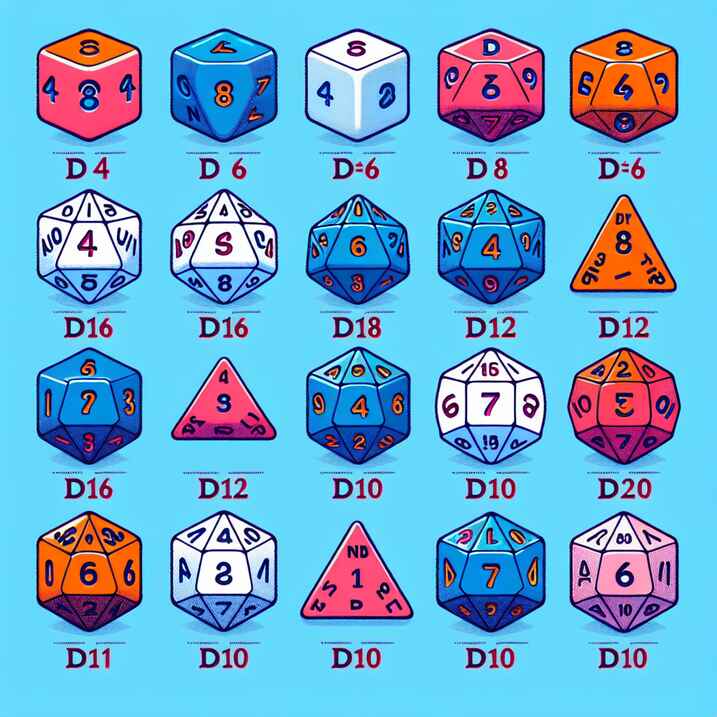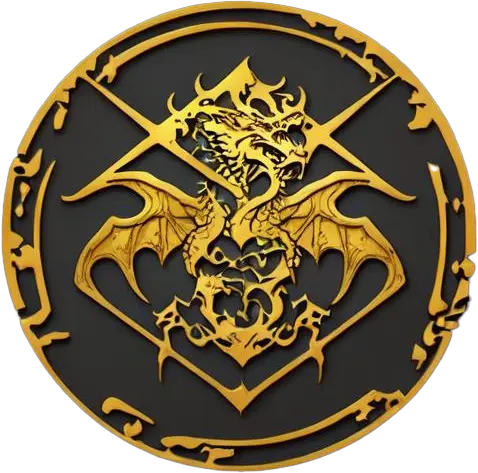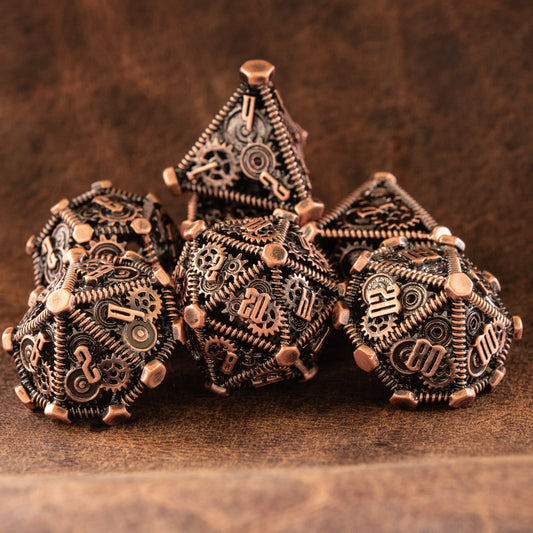
D&D Dice: Which is Which - Your Ultimate Guide to Dungeons & Dragons Dice
Share
D&D Dice: Which is Which - Your Ultimate Guide to Dungeons & Dragons Dice
Introduction
Imagine the thrill of rolling a die and watching your character's fate unfold in a game of Dungeons & Dragons. The anticipation, the excitement, the uncertainty—all hinge on these small, multifaceted objects. Welcome to the world of D&D dice, where each roll can spell triumph or disaster. In this guide, we'll explore the different types of D&D dice, their uses, and tips for choosing the perfect set for your adventures.
Specialized Dice in D&D
D2 - The Coin
Common Uses: Binary decisions
Rolling Mechanism: Heads or tails
Shape: Two sides
The D2, often represented by a coin, is the simplest form of dice in D&D. It's perfect for making binary decisions—yes or no, heads or tails. Whether you're deciding which path to take or determining the success of a 50/50 chance, the D2 has you covered.
D3 - The Triangular Prism
Common Uses: Randomized outcomes with three options
Rolling Mechanism: How to read the result
Shape: Three sides
The D3, though less common, is invaluable for scenarios requiring three possible outcomes. Imagine distributing loot or choosing between three doors in a dungeon. The triangular prism shape ensures that each side has an equal chance of landing face up, providing fair and random results.
D5 - The Pentagonal Prism
Common Uses: Finer granularity in percentile results
Rolling Mechanism: How to read the result
Shape: Five sides
The D5 offers a unique twist with its pentagonal shape, providing more granularity in percentile results. If you need a more nuanced outcome than a D10 can provide, the D5 is your go-to. Perfect for custom rules or specific game mechanics that require a five-sided die.
D7 - The Heptagonal Prism
Common Uses: Specialized systems or unique outcome ranges
Rolling Mechanism: How to read the result
Shape: Seven sides
The D7 is a rare but fascinating die, used primarily in specialized systems or for unique outcome ranges. Its heptagonal shape makes it stand out, and it can add an extra layer of complexity to your game. Whether you're rolling for a unique spell effect or a custom game mechanic, the D7 has a place in your dice arsenal.
Understanding the 7 Standard D&D Dice
D00 - The Percentile Die
Common Uses: Generating values from 1 to 100
Rolling Mechanism: Combining with D10
Shape: Ten faces, numbered 00 to 90
The D00, or percentile die, is essential for generating values between 1 and 100. When combined with a D10, it allows for precise percentile rolls, perfect for determining probabilities or random events. This die is a staple in any D&D set.
D10 - The Pentagonal Trapezohedron
Common Uses: Percentile rolls, damage for larger weapons
Rolling Mechanism: Using two D10s for percentile rolls
Shape: Ten faces
The D10 is a versatile die, often used for rolling damage for larger weapons or spells. When paired with another D10, it can generate percentile results. Its unique shape, the pentagonal trapezohedron, ensures fair and balanced rolls.
D12 - The Dodecahedron
Common Uses: Damage for heavy weapons, higher-level spells
Rolling Mechanism: How to read the result
Shape: Twelve pentagonal faces
The D12, with its twelve pentagonal faces, is often used for heavy weapon damage or higher-level spells. Its larger range makes it ideal for significant impacts in the game, ensuring that powerful actions have equally powerful outcomes.
D20 - The Icosahedron
Common Uses: Attack rolls, saving throws, skill checks
Rolling Mechanism: Critical success and failure
Shape: Twenty triangular faces
The D20 is the iconic die of Dungeons & Dragons, used for attack rolls, saving throws, and skill checks. Its twenty triangular faces make it the most spherical of the dice, ensuring a fair roll every time. The D20 is crucial for determining the success or failure of most actions in the game.
D4 - The Tetrahedron
Common Uses: Damage for small weapons, minor spells
Rolling Mechanism: How to read the result
Shape: Four triangular faces
The D4, with its pyramid-like shape, is used for small weapon damage and minor spells. While it might not roll as smoothly as other dice, its unique shape ensures that each face has an equal chance of landing face up.
D6 - The Cube
Common Uses: Weapon damage, skill checks, character stats
Rolling Mechanism: Standard six-sided die
Shape: Six square faces
The D6 is the most familiar die, used in many board games. In D&D, it's used for weapon damage, skill checks, and character stats. Its cube shape ensures a balanced roll, making it a reliable choice for various game mechanics.
D8 - The Octahedron
Common Uses: Damage for medium weapons, spells
Rolling Mechanism: How to read the result
Shape: Eight triangular faces
The D8, resembling two pyramids joined at the base, is used for medium weapon damage and spells. Its eight triangular faces provide a balanced range of outcomes, making it a versatile die for many in-game scenarios.
In the world of Dungeons & Dragons, dice are more than just tools—they're gateways to adventure. Each roll brings a new twist to the story, shaping the fate of your characters and the world they inhabit. Whether you're a seasoned player or a newcomer, understanding your dice can enhance your gameplay and bring your adventures to life.
Caring for Your D&D Dice
Handling Tips
Clean Hands
Before you dive into your next epic quest, make sure your hands are clean. Oils and dirt can accumulate on your dice, affecting their appearance and performance. Clean hands help maintain the dice's integrity, ensuring each roll is as fair and true as the last.
Proper Surfaces
Rolling your dice on proper surfaces can significantly extend their lifespan. Dice trays are an excellent investment, providing a cushioned area that prevents damage. These trays not only protect your dice but also keep them contained, making it easier to track your rolls during intense gaming sessions.
Inspection and Maintenance
Regular Checks
Regularly inspect your dice for any signs of wear and tear. Look for scratches, chips, or cracks that could affect their rolling. A quick check before each session can prevent any surprises mid-game, ensuring your dice are always in top condition.
Replacement Tips
When should you replace your dice? If you notice any significant damage or if they no longer roll properly, it might be time for a new set. High-quality dice are an investment, and replacing damaged ones ensures your game remains fair and enjoyable.
Storage Solutions
Dice Bags
Dice bags come in various materials and designs, from simple cloth pouches to luxurious leather sacks. Choose one that reflects your style and protects your dice. A good dice bag keeps your collection safe from scratches and easily accessible for your next adventure.
Dice Towers
Dice towers are not just for show—they ensure fair rolls by randomizing the dice as they tumble through. These towers add a dramatic flair to your gaming table and guarantee that every roll is as unbiased as possible.
Dice Trays
Dice trays are essential for keeping your rolls contained and your surfaces protected. They come in various designs and sizes, catering to different preferences. A well-chosen dice tray can enhance your gaming experience, providing a dedicated space for your rolls.
Choosing the Right D&D Dice Set
Factors to Consider
Character Class
Your character's class can influence your choice of dice. A sorcerer might prefer a set with mystical designs, while a barbarian might lean towards rugged, metallic dice. Matching your dice to your character's theme adds an extra layer of immersion to your game.
Design and Aesthetics
Dice come in countless themes, colors, and patterns. Whether you prefer classic designs or something more elaborate, there's a set out there for you. Consider what appeals to you visually and what complements your character's story.
Material Preferences
Dice are made from various materials, including plastic, metal, resin, and stone. Each material has its own feel and weight, impacting your rolling experience. Plastic dice are lightweight and affordable, metal dice offer a satisfying heft, resin dice can feature intricate designs, and stone dice add a touch of luxury.
Quantity of Dice
Additional Dice
Having extra dice, especially D20s and D6s, can be incredibly useful. Multiple D20s allow for quick advantage and disadvantage rolls, while extra D6s are handy for character creation and damage rolls. Investing in additional dice can streamline your gameplay.
Basic Set
A basic set includes one of each standard die: D4, D6, D8, D10, D12, D20, and D00. This set is sufficient for most gameplay scenarios, providing all the tools you need to navigate your adventures.
The Magic of Dice Rolling in D&D
Enhancing Gameplay
Immersive Elements
Enhance your gaming sessions with immersive elements like glow-in-the-dark dice or themed sets that match your campaign. These small touches can make your game more engaging and memorable.
Personal Touch
Customizing your dice set can add a unique flair to your game. Whether it's through personalized engravings, custom colors, or unique materials, a personal touch can make your dice feel truly yours.
The Thrill of Rolling
Critical Hits and Misses
The excitement of rolling a natural 20 or the despair of a critical miss adds a dynamic element to your game. These game-changing rolls can turn the tide of battle, making every session unpredictable and thrilling.
Player Experiences
Anecdotes from intense gaming sessions highlight the magic of D&D. Whether it's a last-minute save or an unexpected twist, these stories showcase the impact of dice rolls on the narrative, bringing your adventures to life.
Call to Action
Explore different dice sets and find the perfect match for your D&D adventures. Whether you're a seasoned player or new to the game, the right dice can enhance your experience and bring your stories to life.
Summary
We've covered the various types of D&D dice, their uses, and tips for choosing and caring for your perfect set. With this knowledge, you're ready to embark on epic quests, armed with the right tools to shape your fate. So, roll those dice and let the adventures begin!


